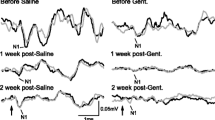Summary
The purpose of this study was to assess whether vestibulotoxicity caused by aminoglycoside antibiotics is influenced by the treatment schedule used: i.e., a single high dose given once daily (o.d.) vs multiple divided doses (tres in die, t.i.d.). Two groups of guinea pigs (5 animals/group) were injected intramuscularly for 21 days with either netilmicin or amikacin 150 mg/kg o. d., whereas other groups received each drug at 50 mg/kg t.i.d. at 8-h intervals. Amikacin was also given at 225 mg/kg o. d. and 75mg/kg t.i.d. Vestibular functions were assessed by measuring vestibulo-ocular reflexes. Acoustic function was also evaluated by measuring Preyer's pinna reflex. Sensory epithelia of the inner ears were evaluated histologically under a scanning electron microscope. Netilmicin failed to affect either the vestibular or the acoustic apparatus in the animal groups receiving the two dosing regimens. Amikacin in a dose of 150 mg/kg per day induced an acoustic deficit which was more severe in the t.i.d. group. The higher dose of amikacin provoked significant lesions of acoustic and vestibular function, irrespective of the dosing regimen used. These data suggest that the o.d. dosing regimen of the aminoglycoside antibiotics might provide effective treatment for infectious diseases without enhancing the risk for vestibular and acoustic side effects.
Similar content being viewed by others
References
Albiero L, Bamonte F, Ongini E, Parravicini L (1978) Comparison of neuromuscular effects and acute toxicity of some aminoglycoside antibiotics. Arch Int Pharmacodyn Ther 233: 343–350
Bamonte F, Monopoli A, Ongini E, Sabetta F, Ferraresi A, Pettorossi VE (1986) Comparative actions of four aminoglycoside antibiotics on the vestibular function in guinea-pigs. Arch Int Pharmacodyn Ther 282:161–176
Bamonte F, Barbara M, Dionisotti S, Ongini E, Melone G, Takumida M, Wersall J (1988) Effects of different dosing regimens on aminoglycoside ototoxicity in guinea pigs. J Drug Dev 1 [Suppl 3]:97–108
Barmack NH, Pettorossi VE (1981) The influence of head orientation and bilateral semicircular canals plugs upon the vertical vestibulo-ocular reflex in the rabbit. In: Gualtierotti T (ed) The vestibular system: function and morphology. Springer, New York Berlin Heidelberg, pp 491–508
Bendush CL (1982) Ototoxicity: clinical considerations and comparative information. In: Whelton A, Neu HC (eds) The aminoglycosides. Microbiology, clinical use and toxicology. Dekker, New York, pp 453–486
Collewijn H (1981) The oculomotor system of the rabbit and its plasticity. In: Barlow HB, Bullock H, Florey E, Grusser OJ, Loos H van der (eds) Studies of brain function. Springer, Berlin Heidelberg New York, pp 1–240
De Broe ME, Giuliano RA, Verpooten GA (1986) Choice of drug and dosage regimen: two important risk factors for aminoglycoside nephrotoxicity. Am J Med 80:115–118
Giuliano RA, Verpooten GA, Verbist L, Wedeen RP, De Broe ME (1986) In vivo uptake kinetics of aminoglycosides in the kidney cortex of rats. J Pharmacol Exp Ther 236:470–475
Jackson GG, Daikos GL, Lolans V (1988) First exposure effect of netilmicin on bacterial susceptibility as a basis for modifying the dosage regimen of aminoglycoside antibiotics. J Drug Dev 1 [Suppl 31:49–56
Kahlmeter G, Dahlager JI (1984) Aminoglycoside toxicity — review of clinical studies published between 1975 and 1982. J Antimicrob Chemother 13:9–22
Kirk RE (1982) Experimental design. Proceeders for the behavioral science. Books and Cole, Monterey, pp 112–114
Parravicini L, Arpini A, Bamonte F, Marzanatti M, Ongini E (1982) Comparative ototoxicity of amikacin, gentamicin, netilmicin, and tobramycin in guinea pigs. Toxicol Appl Pharmacol 65:222–230
Pettorossi VE, Bamonte F, Errico P, Ongini E, Draicchio F, Sabetta F, (1986) Vestibulo-ocular reflex (VOR) in guinea pigs. Acta Otolaryngol (Stockh) 101:378–388
Powell SH, Thompson WL, Luthe MA, Stern RC, Grossniklaus Da, Bloxham DD, Groden DL, Jacobs MR, Di Scenna AO, Cash HA, Klinger JD (1983) Once-daily vs. continuous aminoglycoside dosing: efficacy and toxicity in animal and clinical studies of gentamicin, netilmicin and tobramicin. J Infect Dis 147:918–932
Vogelman BS, Craig WA (1985) Postantibiotic effects. J Antimicrob Chemother 15:37–46
Author information
Authors and Affiliations
Additional information
Offprint requests to: V.E. Pettorossi
Rights and permissions
About this article
Cite this article
Pettorossi, V.E., Ferraresi, A., Errico, P. et al. The impact of different dosing regimens of the aminoglycosides netilmicin and amikacin on vestibulotoxicity in the guinea pig. Eur Arch Otorhinolaryngol 247, 277–282 (1990). https://doi.org/10.1007/BF00176536
Received:
Accepted:
Issue Date:
DOI: https://doi.org/10.1007/BF00176536




